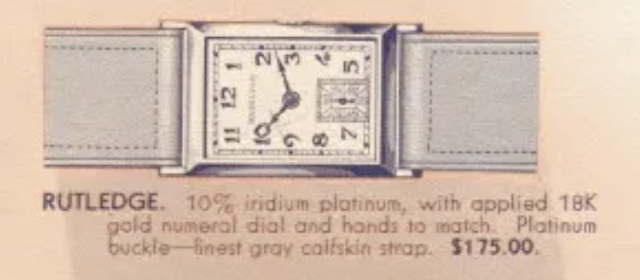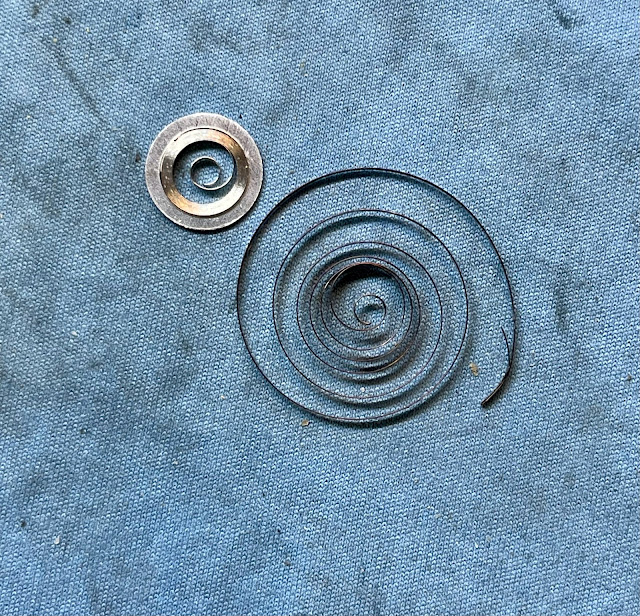If you really wanted a small, but exquisite collection of Hamilton models centered around a single theme you could focus your attention on several potential options. One might be to collect all the CLDs, there are 19 different models, but good luck locating a Tildon.
Another option would be to obtain all of the Lord Lancaster models that feature diamonds in one form or another. There are 21 models to attempt to find and some will cost you plenty.
A third option would be to focus solely on watches cased in 18K gold. There are only 13 cataloged models with 18K cases. One of them is the Barbizon from 1957, which I used to call the Unicorn, as everyone had heard of it but no one had ever seen one - until they did. There's only one known to exist. Priced at $2,200 in 1957, you can imagine why...that would be $23,500 in today's dollars!
One of the 18K models you could try to find is the 1959 the Thin-o-matic T-101. It was mentioned in the 1959 catalog and looked identical to the T-201, which was cased in 14K gold for the hoi polloi. However, the T-201 was offered with a solid 14K bracelet, which would have been pretty special.
You had to wait until 1962 to see an image of the T-101 next to the T-201. If you have an eye for detail you will notice the dial features the stylized H logo. This actually showed up in 1960 and I've always been under the belief that it came as a result of Hamilton acquisition and integration of Huguenin Watch Co in the late 1950s. However, it's the other way around.
One of my Hamilton collector friends is an exceptional detective and sleuth. He pointed out to me that the stylized H logo was first used by Hamilton in 1956, before the acquisition of Huguenin, and formally registered as a trademark in 1958, around the same time as the acquisition. Thus proving once again that correlation doesn't imply causation.
This lends itself to a very common question I receive... "Is my crown correct when it's a pre-1956 watch with a stylized H?". I usually respond, with something like "if the crown fits, wear it", meaning that a crown with a stylized H logo was made by Hamilton and intended to be used. Many watches pre-1952 had tap 8 stems and no Hamilton watches after 1952 had tap 8 crowns - so if a tap 8 crown has an H logo (and many do), it's simply a Hamilton replacement for an original crown.
Anyway, I recently received a T-101 from a fellow collector in need of some TLC. As received it was in decent shape but the dial has obviously been refinished and the printing is a little crudely executed.
The case back is nicely engraved with a presentation for 25 years service. There is no date though to confirm the year this watch was presented.
Inside the case back you can clearly see Hamilton W Co Lancaster PA and 18K. The J with a spear logo indicates the case was made by Jonell Watch Case, Inc. in NY. Notice the rub marks inside the case back from the small oscillating weight inside, aka the micro-rotor. If the rotor rides up it's axle a bit it will rub on the case back.
The movement inside is a 620 caliber, made by Buren for Hamilton. Within a few year Hamilton would purchase Buren too and eventually close the Lancaster plant and move production to Buren's Swiss factory.
If you weren't convinced the dial was refinished, all you have to do is look at the back of it. The scratched in letters indicate it's been redone.
These micro-rotor movements have a lot of parts and disassembling the movement for the first time is a daunting task. The trick is to not have any parts left over when you reassemble it, and to not lose or damage anything during the process.
Success! The movement is back together and running. The only thing not installed is the rotor. I'll put that on after it goes on the timer.
It's running a little fast but that's easy to adjust.
A tweak here, a tweak there, and the beat rate comes into line.
Everything gets put back together and placed back into the case. It's noticeably shinier now, don't you think?
In the "after" photo the watch looks pretty good. Now you can clearly see the printing on the dial is a bit sloppy.
Believe it or not, I was able to find an almost new old stock dial for sale. What a HUGE improvement. The radial finish on the dial is excellent and the printing is an exact match for a 1959 T-201 / T-101. This watch would be the pride of the fleet in any Hamilton collection.























































